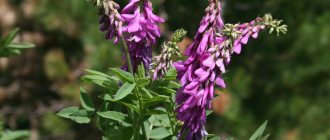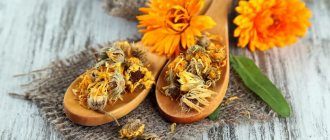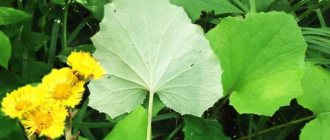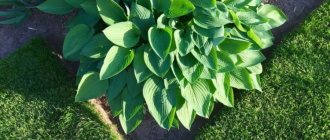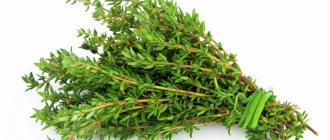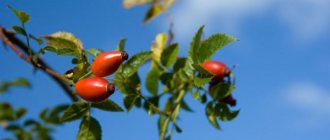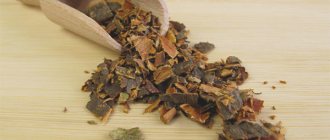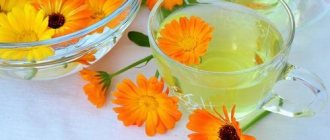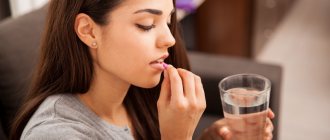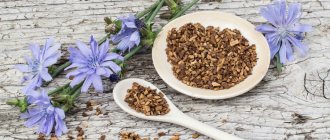The beneficial properties and contraindications of licorice were known back in ancient times. Galen, Dioscorides, and Hippocrates mentioned it in their treatises. Also, the plant was and remains popular in the East. Tibetans use it not only for coughs, but also as a powerful antidote. In addition, the root is credited with the properties of rejuvenating the body and cleansing it of toxins. In China, it is called the root of "blooming appearance" and longevity. It is as valuable in the East as the famous ginseng. The herb is also used in the confectionery industry as a natural sweetener, which is 50 times sweeter than sugar.
Composition of licorice root
The plant has a complex chemical composition. It is given particular importance by substances that have powerful anti-inflammatory effects. They are similar in action to steroid hormones produced by the adrenal glands.
The largest percentage of content in the licorice root system is allocated to a glycoside-like substance - glycyrrhizin (15.23%). In addition - lignin (14%), tannins - (9-14%), isoprenoids - (2.8-14.6%), flavonoids - (4%), coumarins - (3%).
Other ingredients:
- hydrocarbons, starch
- essential oils;
- steroids, pectin substances;
- fatty acid;
- aromatic compounds;
- carbohydrates and similar compounds;
- glucose, sucrose.
Medicinal properties of licorice root
Licorice root, whose medicinal properties were mentioned in ancient books, is widely used for therapeutic purposes. Doctors in ancient China were sure that it prolongs life and preserves youth. In Tibetan treatises it was written that this plant promotes longevity. The Persian physician Avicenna treated kidney dysfunction with this root back in the Middle Ages.
The figure lists the medicinal properties of licorice root.
The high molecular weight carbohydrates and mucous substances in the root structure make it suitable for treating the respiratory tract. The root is also very productive for abnormalities in the gastrointestinal tract. It activates contractions of the walls of internal organs, the production of gastric juice, and promotes rapid scarring of ulcers.
Licorice is known to have beneficial effects on the liver. Its use reduces the risk of tumors and cirrhosis. It helps in the treatment of urolithiasis.
Interest in this herb increased after scientists discovered glycyrrhizic and glycyrrhitic acids in its chemical formula, and then flavonoids, which have:
- antispasmodic effect;
- reducing capillary fragility;
- having an anti-inflammatory effect.
Preparations from the plant are able to balance the functioning of nervous activity; they have been found to help relieve insomnia.
The use of the root is also justified in the fight against skin diseases; extracts from it are suitable as compresses for:
- eczema;
- dermatitis;
- fungal infections.
In recent years, this herb has begun to be used for ailments associated with an imbalance of water and mineral metabolism. For example, a cure for Adison's disease was created abroad.
Does licorice help with cough?
This is one of the main questions that herbalists and naturopaths have to hear.
There is no doubt that licorice really exhibits a high degree of activity and is very effective in the treatment of diseases of the throat, nasopharynx, and pharynx. This is a proven remedy that has been used for a long time. Previously, it was a folk remedy that was not recognized by traditional medicine. However, due to its high effectiveness, doctors were later forced to recognize licorice as an official medicine that helps in the fight against various types of cough. Today, licorice is used as an independent medicine, and is also part of various complex medicines and herbal preparations.
Possible harm
Licorice root, whose medicinal properties are beyond doubt, can cause harm if used uncontrollably and if restrictions on use are ignored. Since licorice stimulates the functions of the adrenal cortex, it will not bring benefit to those who already have increased activity of these organs: pressure surges may occur and deviations in the functioning of the endocrine system may worsen.
It is also necessary to remember the hormone-like properties of this root. People whose estrogen levels are disturbed (with mastopathy, oncology) should not use fees on this basis. Negative changes in the sexual sphere may also occur - enlarged mammary glands, decreased libido.
Licorice retains fluid removal from the body, and its excessive use can cause swelling and lead to gastrointestinal irritation. It is not recommended to use licorice in combination with diuretics, as this can cause potassium to be washed out of the body.
Homemade syrup
An expectorant is easy to make at home. For this you will need:
- licorice extract - 8 grams;
- sugar syrup - 160 grams;
- alcohol or vodka - 20 grams.
The ingredients are thoroughly mixed and left for a week in a dark place. Used in the same way as a pharmaceutical product.
Licorice root extract can be purchased at the pharmacy. The substance is sold in large containers and has the appearance of a thick, sticky mass. It is used to prepare pharmaceutical and home remedies.
Indications for use
Licorice is recommended for use in cases of presence in the body:
- gastritis or ulcerative disorders of the gastrointestinal tract;
- kidney disease (pyelonephritis);
- diseases of the intestinal mucosa;
- diabetes mellitus (especially in children);
- biliary dyskinesia;
- decreased activity of the adrenal cortex;
- respiratory diseases;
- skin pathologies;
- Addison's disease;
- obesity;
- poisoning
Licorice syrup for children
The drug has long proven its effectiveness in treating coughs in children, earning the trust of mothers and doctors. The instructions for use recommend using licorice concentrate for children over 1 year of age.
Attention. Licorice syrup contains sugar and a high percentage of ethyl alcohol. This should be remembered and not given medicine to children with a history of diabetes mellitus and a tendency to allergies.
It is better if a doctor prescribes a cough medicine. He will also indicate the duration of treatment and identify possible contraindications.
Contraindications for women, men, children
The use of this root is contraindicated if the patient:
- high pressure;
- increased activity of the endocrine glands;
- serious heart rhythm disturbances;
- impaired blood clotting;
- platelet count is reduced;
- serious liver diseases.
Licorice is not recommended for use by pregnant women, and it is also not applicable in combination with medications that lower blood pressure and diuretics.
How to use licorice root for various diseases: recipes, doses
Licorice root, the medicinal properties of which are well known among the people, is actively used in the fight against ailments at home. When self-treating, it is important not to exceed the dosage of the drug.
Licorice for constipation
The laxative effect of the root is explained by the action of liquidation glycoside, which releases flavonoids that relax spasms of the sphincters of the digestive system, thereby improving the process of bowel movement.
- Recipe 1. Ingredients: licorice bare roots (1 tbsp). The crushed raw materials are diluted with 500 ml of boiling water, then 15 minutes. boil over low heat, cool, filter. Drink the resulting decoction 50g before meals.
- Recipe 2. Ingredients: licorice roots (20 g), dill seeds (5 g). Everything is crushed, mixed and poured with 200 ml of boiling water. Close the dishes and wrap them up. Take 100 ml one hour after a meal.
- Recipe 3. Ingredients: licorice root (1 tbsp); alder buckthorn bark (2 tbsp); coriander fruits (1 tbsp.). The ingredients are crushed, mixed, 2 tbsp. l. 400 ml of boiling water is poured into this mass, infused in the dark for 3 hours, filtered. Drink 40-50 ml half an hour before going to bed.
Licorice root for dry cough
In this case, collections with licorice root dilute mucus and help remove them from the respiratory tract.
- Recipe 1 - decoction: grate licorice root (100g), add water, cook until boiling, boil for 5 minutes. and infuses for 3 hours. Taken orally by sip 3 times throughout the day.
- Recipe 2 - infusion. Ingredients: licorice root (3 tbsp), high mullein flowers (2 tbsp), anise flowers (4 tbsp), marshmallow roots (3 tbsp). If necessary, the components must be crushed and mixed. 1 tbsp. The mixture is poured with half a liter of boiling water, infused for half an hour and filtered. Take a cup 3 times throughout the day.
For nephritis
Since licorice is known for its strong diuretic effect, its use is practiced to treat the kidneys.
Recipe 1:
- lovage roots;
- wolfberry roots;
- licorice roots;
- heather fruits.
Combine the ingredients in equal parts, 1 tbsp. l. Add the resulting mixture to 200 grams of boiling water, leave for about 6 hours, then boil for about 20 minutes and filter. Drink about 3 glasses throughout the day.
Recipe 2:
- licorice roots (one and a half spoons);
- marshmallow roots (one and a half spoons);
- celandine grass (one and a half spoons).
Combine ingredients. 1 tbsp. Stir the mixture into 200 grams of boiling water, leave for half an hour, then filter. Drink 3 glasses throughout the day.
For tuberculosis
The healing properties of licorice root infusions are taken into account in the treatment of tuberculosis (expectorant and anti-inflammatory).
Recipe 1:
- licorice roots;
- horsetail herb;
- coltsfoot;
- knotweed herb;
- piculin;
- lungwort.
All ingredients are combined in equal parts and crushed, 3 tbsp. l. The resulting collection is poured with 600 ml of boiling water, then it must be left for an hour and a half and drunk 70 mg 3 times throughout the day.
Recipe 2:
- licorice roots;
- thermopsis;
- marshmallow roots;
- coltsfoot.
All ingredients are combined in equal parts and crushed, 1 tbsp. l. herbs in 200g of water, boil for 15 minutes, leave for 40 minutes. and drink throughout the day.
For stomach ulcers
Thanks to its antispasmodic and antihistamine effects, licorice promotes the speedy healing of gastric ulcers. Observations have shown that drinking 50 g of juice per day helps dull pain, and after about 2 months the ulcer heals.
- Recipe 1: licorice roots (2 tsp) are fried in a frying pan and 400 mg of boiling water is poured in, infused for 7 hours. It is recommended to drink 50 drops throughout the day.
- Recipe 2: 1 gram of juice from fresh licorice roots is poured into 100 ml of hot water, divided into three equal portions and drunk warm 3 times throughout the day.
- Recipe 3: dry crushed licorice roots (2 tbsp) are poured into 500 g of water, boiled for 20 minutes, infused for about 2 hours, filtered and drunk a cup 4 times throughout the day.
For prostate adenoma
- Recipe 1: licorice roots (1 tbsp) boil for 10 minutes. in 500g of water, boil for 15 minutes, cool and filter. The decoction is consumed 70g 3 times throughout the day before meals. The course of treatment is 3 weeks, then there is a break of 14 days. You can also alternate with taking a decoction of burdock roots.
- Recipe 2: galangal (1 tsp); licorice roots (1 tsp); stinging nettle roots (1 tsp). The mixture of these components is poured with 600 ml of cold water, boiled and cooked for 3 minutes, infused for 15 minutes, filtered. It is recommended to drink 1 glass in the morning and 1 glass in the evening.
- Recipe 3: birch buds; licorice roots; corn columns; hoof grass; cornflower flowers; bearberry leaves. The ingredients are taken in equal proportions, crushed and mixed. After which the mixture is poured with boiling water (1 liter per 2 tablespoons of composition) and infused overnight. You need to take the infusion 150 ml per 30 minutes. before the meal. The course lasts 2 months, after which a pause is necessary.
For asthma and bronchitis
Recipe 1:
- marshmallow roots (15g);
- licorice rhizome (40g);
- high mullein flowers (10g);
- fruits of dill (10g).
Chop plant parts, mix, 1 tbsp. pour into 200g of cold water, leave for 2 hours, then boil for a few minutes, cool and filter. The resulting decoction must be drunk warm within 24 hours.
Recipe 2: licorice roots (30 g) are poured into 200 g of boiling water, boiled for about 15 minutes, infused for 2 hours. Use 1 tbsp. l. 4 times in equal periods in 1 day.
Recipe 3:
- licorice roots (5);
- poppy flowers (2);
- marshmallow roots (2);
- coltsfoot (1);
- thigh anise fruit (1);
- mullein densely flowered (1);
- wild mallow flowers (2).
1 tbsp. l. The resulting collection is infused in cold water (200g) for 2 hours, then boiled for 7 minutes, cooled and filtered. It is necessary to take 70 g several times throughout the day.
For arthritis and eczema
Decoctions and infusions of licorice root are well suited for scarring and getting rid of viral eczema. The glycerritic acid contained in it activates the production of interferon, which has antiviral properties.
A decoction is prepared from licorice root (1 part roots and 10 parts water). This decoction is recommended as a lotion for eczema. The effects of licorice can be compared to the anti-inflammatory effect of the hormone cortisone on the body. Substances found inside the root can inhibit the enzyme that causes arthritis.
- Recipe 1: licorice root (2 tsp) is fried, 400 ml of boiling water is poured in and left for about 8 hours. It is recommended to use 40 drops per day.
- Recipe 2: licorice roots (10 g) are placed in a bowl, 200 ml of boiling water is added, the water bath is covered and left for 20 minutes. Then the resulting decoction is 50 minutes. infused and filtered. At the end you need to add water to replenish the volume. The medicine is used 1 tbsp. 5 times throughout the day, regardless of meal time.
- Recipe 3: licorice root; crane grass; meadowsweet grass; wormwood herb; celandine grass; yarrow herb; alder cones. Take the ingredients in equal parts. Next, prepare the infusion for washing and lotions as follows: 2 tbsp. spoons of crushed plant mass are poured into 400 ml of boiling water, poured into a thermos and infused overnight. It must be filtered before use. Using a cotton swab, wash the affected area. After this, lotions are made: gauze or a sterile bandage is moistened with the prepared infusion, lightly wrung out and applied to the area with eczema. The bandage is periodically moistened with infusion when it dries; it must be changed every 4 hours.
Recommendations
Official medicine has recognized the effectiveness of licorice. Pharmacies offer licorice syrup for coughs and colds, just like industrial preparations.
The drug easily relieves dry, painful cough and increases sputum production. Promotes the rapid removal of microbes from the body. An inhibitory effect on other pathogenic microorganisms - staphylococci, mycobacteria - was revealed. Antitumor effects were also detected.
The antimicrobial and antibacterial properties of the plant's composition can resist pulmonary diseases.
The drug has been successfully used to combat tuberculosis.
Method of administration
The course of treatment with syrup is 7-10 days.
The repeated course of treatment is determined by the doctor. When treating gastrointestinal diseases, the drug should be used 3-4 times a day, undiluted.
While taking cough syrup, you should regularly check your blood pressure to see if it is elevated. It is necessary to monitor swelling that may appear during the use of the product. They indicate fluid retention in the body. If alarming symptoms appear, you should stop taking the drug and consult a doctor.
Thanks to the flavonoid compounds contained in licorice root, permeability and strengthening of blood vessels are normalized.
The medicine is successfully used for pathological processes in the kidneys, copes with urolithiasis, inflammation of the urinary tract and pyelonephritis.
The product should be stored in a dark place. The storage temperature of licorice root syrup is no higher than 25 degrees. Shelf life: 2 years. After this period, taking licorice is prohibited.
How to properly prepare raw materials
Licorice root (medicinal properties begin to appear in 4-year-old plants) is dug up in November or March. After digging, the rhizomes are separated from the rest of the plant and washed; they must be cut into pieces, having first removed the top layer.
If the roots are too thin, it is not necessary to clean them. The raw materials should be dried in sunny places or indoors at a temperature of maximum 60 C. The raw materials should be roots up to 6 cm thick, shaped like a cylinder. Before cleaning, the roots are covered with a brownish cork.
Peeled roots:
- have a yellowish-brown color;
- fibrous at the fracture;
- sweetish in taste and odorless.
The percentage of too dark and unpeeled rhizomes in the structure of raw materials should not be higher than 10%, the amount of ash in them should not exceed 8%, in peeled ones - 7%. The roots have a shelf life of 10 years. They should be stored in well-ventilated and not damp areas.
Release form
In the pharmacy chain you can purchase licorice root in the form of:
- Syrup is a thick brown liquid with a characteristic odor. Additional substances include confectionery sugar, purified water and ethyl alcohol. The drug is available in bottles of 50 or 100 ml.
- Tablets that, in addition to licorice, may contain lactose, titanium dioxide, talc or starch. This medicine is suitable for those who cannot stand the peculiar taste of licorice.
- Thick extract - sold in impressively sized containers - glass jars of 1 or 2 kg, as well as two-layer polyethylene bags of 10, 20, 30, 40, 50 kg.
- Dry extract – a substance obtained by aqueous extraction, concentration and subsequent drying. Packaged in filter bags of 0.1 g.
- Crushed dry roots of the plant, packed in cardboard boxes weighing 100 g.
Be careful! It is better that the dosage form of the drug is selected by the attending physician, since each of them has its own characteristics. For example, tablets are prohibited for children under 12 years of age, and in case of stomach problems, syrup, which has the most enveloping properties, is preferable among all types of extract.
Pharmaceutical preparations based on licorice root: names, instructions
Several main types of pharmaceutical medicines are made on the basis of licorice root: licorice root extracts (thick and dry), root syrup, complex licorice root powder and breast elixir. The chest elixir has an expectorant effect and is used mainly to treat the respiratory system and respiratory tract.
Thick and dry extracts are also distinguished by anti-inflammatory and antispasmodic properties , and in addition to treating the respiratory tract, they are also used for peptic ulcers of the stomach and intestines.
In addition to the listed effects, licorice root syrup combines immunostimulating and antiviral properties in its range of actions. It is used both for the treatment of colds and viral diseases, respiratory tract (bronchitis, tracheitis, pneumonia, bronchial asthma, atelectasis), and for healing the digestive system of the body.
Complex licorice powder is used primarily as a laxative for constipation and intestinal problems.
There are also herbal medicines based on licorice root in the form of tablets (“Glyciram”), as well as medicines in the structure of which licorice root is combined with other herbal ingredients. (“Fitonsol” combines the healing properties of licorice and ginseng).
Basic licorice-based medications are used and dosed as follows:
| breast elixir | thick licorice root extract | dried licorice root extract | licorice root syrup | complex licorice root powder | |
| instructions for use | Use internally, dilute with water before use | prepare an infusion: pour briquettes (3-5) with water (200 ml), heat in a boiling water bath, cool, strain. | prepare an infusion: dilute 20 g of extract in 200 ml of water, consume orally | use internally, dilute with water before use (20 ml syrup per 100 ml water) | used internally, before use, dilute the powder in hot water (10g per 100ml of water) |
| dosage | adults: 35 drops 3 times a day, for children: the number of drops is equal to the age of the child | take 200 ml orally 3 times. per day | 1 tbsp. l. 4-5 r. per day | 1 tsp each 3 r. per day | 2 tsp each 1-3 r. per day |
Beneficial features
The centuries-old history of the use of licorice in medicine has made it possible to determine a list of its properties:
- expectorant;
- enhancing;
- diuretic;
- anti-inflammatory;
- rejuvenating;
- cleansing;
- anticancer;
- laxative;
- antispasmodic.
The golden rod is also a good antispasmodic https://poleznoevrednoe.ru/zdorovie/zolotaya-rozga-lechebnye-svojstva-i-protivopokazaniya/
However, behind this list there is a whole list of diseases that licorice root treats.
What does licorice root help with:
- Its most famous property is an expectorant. Substances from the composition of licorice sharply increase the amount of mucus released, which means that microbes are removed from the lungs and a speedy recovery occurs. The plant is suitable for the treatment of any diseases of the lungs and bronchi;
- The enhancing effect of licorice root is that when used simultaneously with certain medications, it leads to an increase in their effect, which in some cases is useful;
- The glycyrrhizic root is useful for the immune system and has a general strengthening effect;
- Licorice is effective in the treatment of ulcers, gastritis, and digestive disorders, because This product has an enveloping effect. Causes a laxative effect, stimulates the production of gastric juice, eliminates heartburn. Helps with gastritis with high acidity;
- Licorice has a beneficial effect on the body when losing weight: it replenishes the loss of mineral salts, speeds up metabolism, and prevents the formation of new fat deposits;
- Glycyrrhiza (as the plant is also called) not only perfectly removes waste, cholesterol and toxins from the body, but also reduces the effect of radiation on the body. Licorice root is also used to cleanse lymph: the healing plant dilutes it, increasing lymph flow. To cleanse the lymphatic system, a decoction of the rhizome is used;
- Liquorice increases the activity of the nervous system, relieves weakness, increases concentration and attention;
- For diabetics, the sweet root can act as a sugar substitute, a natural sweetener that does not affect blood glucose levels;
- The herbal remedy is effective for inflammatory skin diseases, acne, rashes;
- Glycyrrhiza will help with low blood pressure and relieve spasms of smooth muscles;
- The cosmetic properties of licorice are also high: licorice root is used against age spots, rashes, inflammation on problem skin, against dandruff, brittle hair;
- The beneficial effect of the plant on the body of infected patients in the complex treatment of HIV has been proven;
- Research is underway into the anti-cancer properties of licorice, and success has been proven in animals.
You may be interested to know that rowan also has anti-cancer properties. You will learn all the details from this article...
You will learn more about the benefits of licorice root from the video:
Licorice affects hormonal levels: with prolonged use, it inhibits testosterone production.
Is this beneficial or harmful for women?
The phytoestrogens contained in licorice help in the treatment of hot flashes during menopause, cycle disorders, and PMS. Is it possible to drink licorice root during pregnancy and breastfeeding? The use of licorice root during lactation and pregnancy is prohibited, only if prescribed by a doctor, because changes in hormone levels can affect both the amount of milk and the development of the child. In any case, the risk to the child’s body and the possible benefit to the mother must be assessed. Another undesirable effect of licorice during pregnancy is the possible appearance of edema.
Licorice for children
Is it possible to give licorice root to children? It is strictly contraindicated for babies under one year old. At an older age, use for children is limited to its expectorant properties as part of breast milk as prescribed by a doctor. The duration of use of licorice for children is no more than 8-10 days without exceeding the dosage.
Turnips also have an expectorant effect https://poleznoevrednoe.ru/pitanie/chem-polezna-i-vredna-repa-poleznye-svojstva-i-protivopokazaniya/
Benefits and harms for men
The effect of licorice rhizome on men is ambiguous. Licorice is indicated for the treatment of urinary tract problems (for example, prostate adenoma). But by influencing testosterone levels, namely by reducing it, licorice can cause even greater harm to men in the form of impaired potency and infertility.
Possible side effects
When using drugs based on licorice root, the following side effects may occur:
- diarrhea;
- allergic reactions;
- decrease in potassium content in the blood (with increasing dosages and long-term use);
- increased blood pressure;
- edema (a consequence of impaired water-salt metabolism).
It is recommended to use it with caution for people diagnosed with diabetes mellitus (high percentage of sugar in medications), as well as for children due to the presence of ethyl alcohol in the structure. Licorice root is widely used in both official and alternative medicine, as it has many healing properties.
It is used for diseases of the gastrointestinal tract, respiratory tract, nephritis, joint diseases and problems with the skin. On its basis, effective medical preparations have been created - syrups, powders, extracts. But in order to effectively use this medicine for diseases, it is necessary to become familiar with its side effects and take into account the restrictions on its use.
Author: Katerina Sukhorskaya-Kalashnikova
Pharmacy syrup and application features
Pharmacy licorice cough syrup is very popular due to its effectiveness and ease of use. Children especially love to drink it, so it needs to be hidden from them.
Adults drink syrup three times a day. At the same time, dissolve one dessert spoon of syrup in half a glass of water. This is necessary in order to reduce the effect on the gastric mucosa.
In children
The good thing about licorice-based cough syrup for children is that it rarely causes side effects in children. Mothers speak well of this medicine and often use it to cure their child.
But you need to know that the syrup is prepared on the basis of alcohol, so it can be given to children at least one year old and diluted with water.
Children under 12 years old are given 0.5 tsp three times a day. syrup. Over 12 years old you can give a full spoon. An overdose should not be allowed, as stomach upsets may occur.
During pregnancy
The use of licorice cough syrup by pregnant women is allowed, but it is necessary to consult a doctor. If pregnancy occurs with complications, taking medications may worsen the condition.
In addition, pregnant women have a weakened immune system due to hormonal changes in the body. Because of this, the likelihood of side effects is increased.
